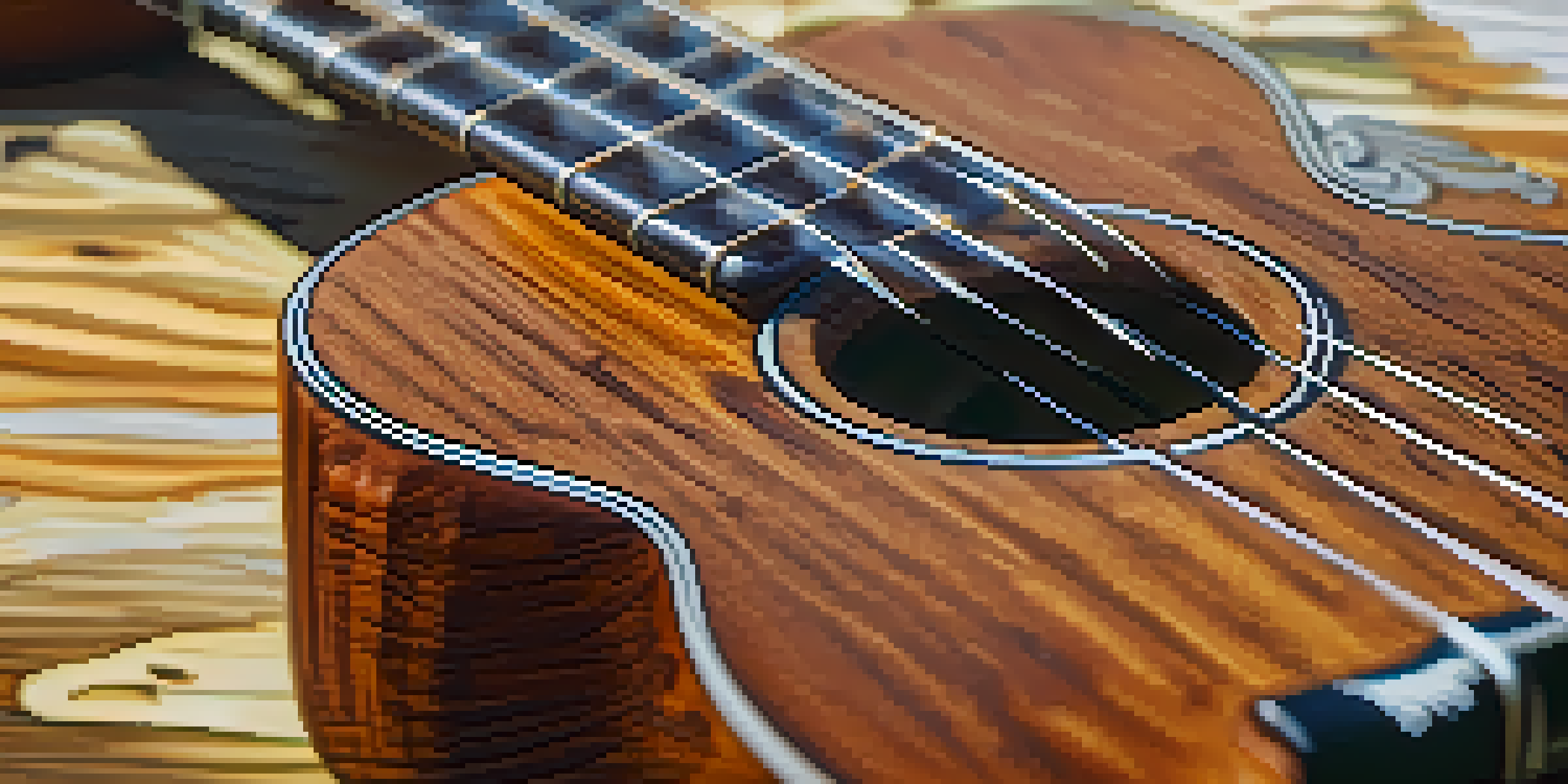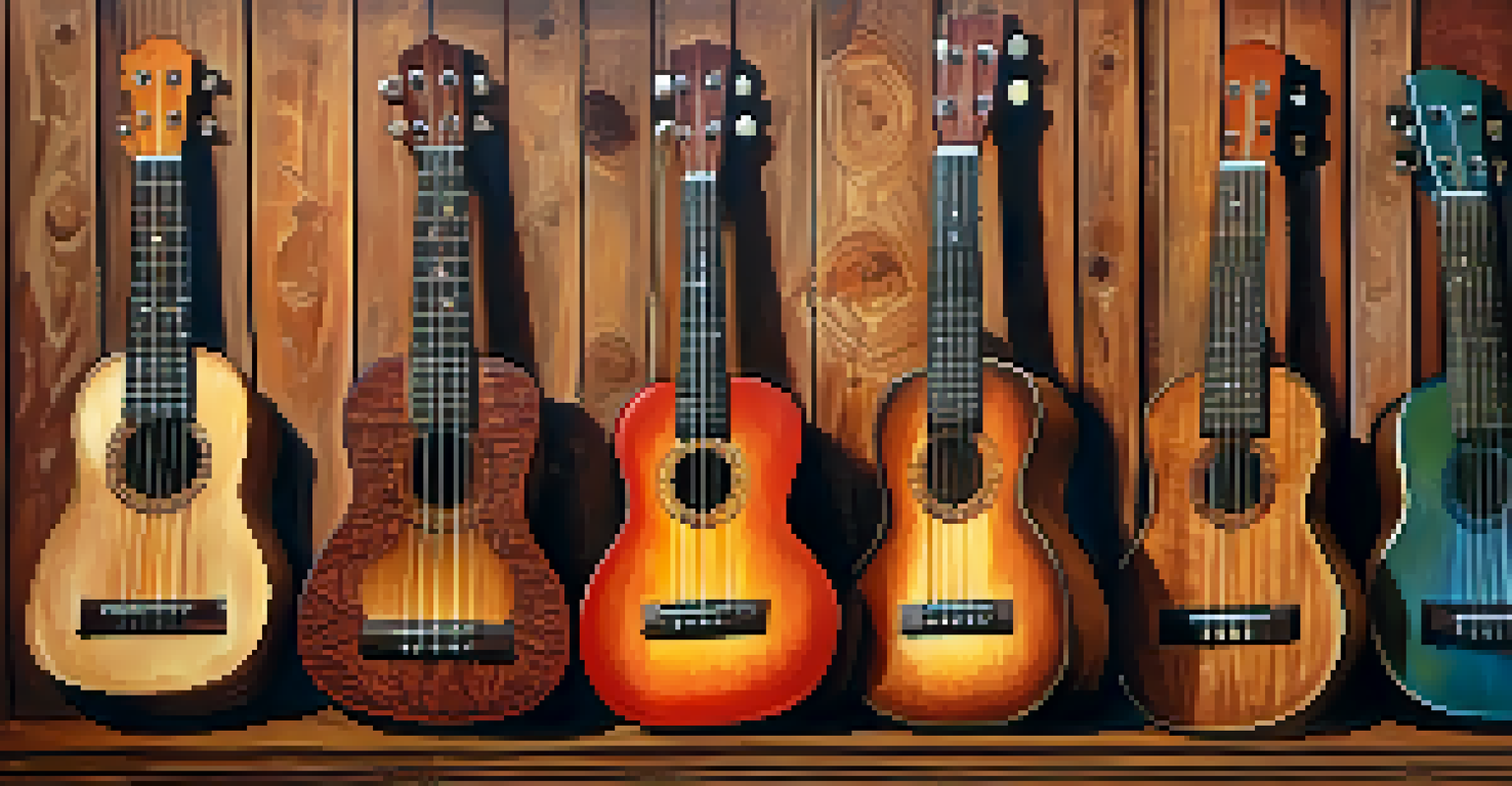The Early Days of Ukulele Design: Roots and Influences

Origins of the Ukulele: A Blend of Cultures
The ukulele's journey begins in the 19th century, rooted in the Hawaiian islands. It was inspired by Portuguese instruments like the machete, which traveled with immigrants to Hawaii. This cultural blend marked the ukulele as a unique symbol of Hawaiian music and identity.
The ukulele is the happiest instrument in the world.
As the ukulele gained popularity, it became a staple in Hawaiian music, often associated with joy and celebration. Its cheerful sound resonated with both locals and visitors, establishing its place in the hearts of many. This early adoption was crucial in setting the stage for the instrument's future.
The merging of Portuguese craftsmanship and Hawaiian spirit is what gave birth to the ukulele we know today. This cultural crossover laid the foundation for its design, influencing its shape, size, and sound. It’s a classic example of how music evolves through collaboration and shared experiences.
Early Ukulele Designs: Features and Variations
Originally, ukuleles were crafted from local Hawaiian woods like koa, prized for their rich tones. These early designs featured a smaller body and a distinctively high-pitched sound, captivating audiences. The unique choice of materials contributed significantly to the instrument's warm, inviting timbre.

Over time, the instrument evolved, leading to variations such as the soprano, concert, and tenor ukuleles. Each type brought its own character, expanding the ukulele's versatility in music. This variety allowed musicians to express themselves in different styles, further enriching its appeal.
Cultural Roots of the Ukulele
The ukulele originated in Hawaii, blending Portuguese craftsmanship with local influences to create a unique musical identity.
The craftsmanship of these early ukuleles was meticulous, showcasing the skill of local artisans. Their attention to detail ensured that each instrument not only sounded beautiful but also looked exquisite. This emphasis on quality helped solidify the ukulele's reputation as a beloved musical instrument.
The Role of Hawaiian Music in Ukulele Popularity
Hawaiian music played a pivotal role in the ukulele's rise to fame, especially in the early 20th century. Traditional songs often featured the instrument, making it an essential part of cultural celebrations. The infectious melodies and rhythms drew in listeners, sparking interest beyond the islands.
Music is the universal language of mankind.
The 1915 Panama-Pacific International Exposition showcased Hawaiian music, propelling the ukulele into the mainstream. Performers captivated audiences with their lively tunes, leading to a surge in ukulele sales. This event marked a turning point, introducing the instrument to a wider audience across the United States.
As Hawaiian music gained traction, so did the influence of the ukulele on various genres. Musicians from jazz to pop began incorporating the instrument into their creations, further expanding its reach. This cross-genre appeal solidified the ukulele's status as a versatile and cherished musical tool.
Key Influencers: Musicians and Innovators
Several musicians and innovators played a significant role in shaping the ukulele's design and popularity. Notable figures like Roy Smeck, often referred to as the 'Wizard of the Ukulele,' showcased the instrument's potential through captivating performances. His charisma and skill inspired many to pick up the ukulele themselves.
Another influential figure was ukulele maker and designer, John H. O. Smith, whose craftsmanship elevated the instrument's quality. His designs focused on enhancing sound and playability, which attracted both beginners and seasoned musicians alike. Smith's innovations helped the ukulele evolve into a serious instrument for musical expression.
Evolution of Ukulele Designs
Over time, the ukulele has evolved into various forms, such as soprano and tenor, showcasing its versatility and appeal to different musical styles.
These key influencers not only popularized the ukulele but also shaped its design through their artistic input. Their contributions ensured that the ukulele remained relevant across generations, appealing to both traditionalists and contemporary players. The legacy of these musicians and innovators continues to resonate in today's music scene.
The Ukulele's Global Journey: From Hawaii to the World
As the ukulele's popularity soared in the United States, it began to spread globally, reaching Europe and beyond. This global journey was fueled by the rise of travel and communication in the early 20th century. The instrument quickly became a favorite among musicians across various cultures, showcasing its universal appeal.
In places like the United Kingdom, the ukulele found a warm welcome in folk music circles. Artists incorporated it into their performances, often blending it with traditional instruments. This fusion of styles led to unique sounds and genres that expanded the ukulele's musical repertoire.
The ukulele's adaptability allowed it to transcend cultural boundaries, becoming a symbol of joy and creativity worldwide. Today, you'll find vibrant ukulele communities in countries across the globe, each adding their own twist to its rich history. This ongoing evolution highlights the instrument's enduring charm and versatility.
The Evolution of Ukulele Manufacturing Techniques
With the rise in demand for ukuleles, manufacturing techniques began to evolve, leading to mass production. Early ukuleles were handcrafted, but as popularity grew, manufacturers sought ways to create instruments more efficiently. This shift allowed for greater accessibility, making the ukulele available to a broader audience.
Modern manufacturing methods have improved sound quality and consistency, while still honoring traditional craftsmanship. Innovations in materials and techniques have led to the creation of durable, affordable ukuleles that cater to beginners and professionals alike. This evolution has played a crucial role in the instrument's resurgence in recent years.
Global Popularity and Community
The ukulele's journey from Hawaii to the world has fostered a vibrant global community, uniting musicians across cultures through its joyful sound.
Despite these advancements, many luthiers continue to create handmade ukuleles, emphasizing quality and artistry. This blend of traditional and modern techniques ensures that players have a wide range of options to suit their preferences. The balance between craftsmanship and innovation keeps the ukulele's legacy alive and thriving.
The Modern Ukulele: Trends and Innovations
Today, the ukulele is experiencing a resurgence, with new trends and innovations emerging constantly. Musicians are experimenting with different styles, incorporating the ukulele into genres like rock, jazz, and even classical music. This versatility showcases the instrument's ability to adapt to contemporary tastes.
Innovations in technology have also influenced ukulele design, with features like built-in pickups and electronic tuners becoming commonplace. These enhancements make it easier for musicians to amplify their sound and achieve precise tuning. Such advancements cater to the needs of modern players while maintaining the instrument's charm.

The modern ukulele community is vibrant and diverse, with online platforms fostering collaboration and sharing. Social media has played a key role in connecting players worldwide, allowing them to learn from each other and showcase their talents. This sense of community continues to inspire new generations of ukulele enthusiasts.